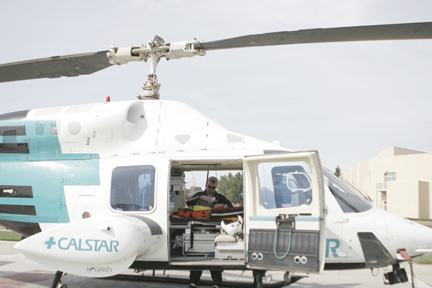No typical day for CALSTAR crew
When the Gilroy crew of the California Shock/Trauma Air Rescue
(CALSTAR) reports to work, they never know what their day will be
like.
No typical day for CALSTAR crew
When the Gilroy crew of the California Shock/Trauma Air Rescue (CALSTAR) reports to work, they never know what their day will be like.
For the day crew, the shift starts at 9:45 a.m., and they arrive fifteen minutes early.
Flight nurse David Wiebe and pilot Evan Toolajian arrived. Flight nurse Jamie Hill had just completed 12 hours of his 36-hour shift.
Flight nurses usually work in 24-hour shifts, though they may work 36-hour shifts. A pilot is limited to a 12-hour shift due to the Federal Aviation Association rules, Hill said.
All flight nurses are Advanced Life Support certified. This means they can provide advanced airway treatments through intubation (a process in which a tube is inserted into the trachea of the patient) and administer drugs, according to a protocol approved by CALSTAR’s medical director, Hill said.
Before leaving, flight nurse Jeff Horner, who had just finished his shift, talked about his favorite part of the job.
“I like being in a pre-hospital setting,” Horner said. “We have a lot of autonomy, and with it comes responsibility and accountability.”
The crew started their day with checks of the helicopter. Toolajian checked the aircraft for safety, while Hill checked the supplies and medicines.
After the aircraft passed stock and safety checks, the crew awaited calls.
The CALSTAR Gilroy base – which responds to calls throughout the region, including some from San Benito – is a small structure in the parking lot adjacent to Saint Louise Regional Hospital. It has a kitchen, a computer room, one bedroom for each of the three crew members, two bathrooms, and living room with a television.
A call from the dispatch center will ring white phones all around the base. Every room except for the bathrooms has one. If a crewmember is in the bathroom when a call comes in, they will be notified by a pounding on the door, Hill said
When they are not at the base, the crewmembers carry radios to communicate with each other.
Calls dispatched to the crew come from a central dispatch center, which determines which crew is closest and available, Hill said.
CALSTAR is a nonprofit agency with several bases. The cost of a flight averages $15,000 to $20,000 depending on the care provided, said Michael Baulch, both a registered nurse and an attorney, who is the Program Manager for CALSTAR bases 2 (Gilroy) and 5 (Salinas).
Usually the details of the patient, such as age and condition are not given to the crew until they have accepted the call and are en route, he said.
“It’s three to go, and one to say no,” Hill said.
Both flight nurses and the pilot must all agree to take a call for the crew to go out. The patient detail is not given right away so that it doesn’t influence the crew’s decision to take a call. The crew might refuse a call for reasons such as inclement weather or concerns about safety of the aircraft.
After lunch, while the flight nurses used time to work on paperwork, Toolajian took a short nap.
“The crew is encouraged to nap when tired, as they never know when calls are coming in, and what time they will be back to the base,” Hill said.
The aircraft has two engines and can fly with one in an emergency.
“In turbulent weather we can still care for patients,” he said.
The crew is comfortable with riding in the helicopter, they said.
“I’ve always considered my drive to work the most dangerous part of my day,” Wiebe said.
At a little after 3:00 p.m., the phone rang for the first time since the day began.
“When the phone rings, I just wonder about the call, what we will be sent to,” Hill said. “I’m sure other people [on the crew] might feel adrenaline.”
The worse off the physical condition of the patient, the harder the patient will be to treat medically, Hill said.
“Some calls can be more emotionally hard to handle than anything else,” he said. “Pediatric calls, particularly for critically injured children are the most difficult [for me] to handle emotionally.”
Despite the emotional calls, the job has its rewards, Hill said.
“I like being involved with someone’s worst day, and the chance to make it better,” he said.
With their helmets on, they waited for further instructions. After 15 minutes, they received a call over the radio to fly to a traffic accident.
A few minutes after take off, the crew received word that they were no longer needed as the person in the accident had died at the scene. In cases like this where the flight is cancelled before reaching the patient, CALSTAR absorbs the cost of the flight, Baulch said.
As it grew darker back at the base the crew watched “Dr. G: Medical Examiner,” a show about a real-life doctor who performs autopsies.
“This is a good show,” Hill said. “I can usually figure out the diagnoses before they reveal it.”










